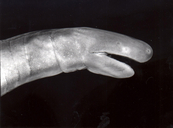|
Dermophis oaxacae (Mertens, 1930)
Oaxacan Caecilian | family: Dermophiidae genus: Dermophis |
| Species Description: Mertens, R. 1930 "1929". "Beiträge zur Herpetologie Mexikos. IV. Bemerkungen über die von Herrn. Dr. L. Lafrentz in Mexiko gesammelten Amphibien und Reptilien." Abhandlungen und Berichte aus dem Museum für Natur- und Heimatkunde zu Magdeburg 6: 153–155. | |
|
Etymology: The species is named for the Mexican state, Oaxaca, in which the type specimen was collected. |
|
 © 1998 Marvalee H. Wake (1 of 2) |
|
|
|
Description Coloration in life is blue-black; ethanol-preserved specimens are brown-violet, with the dorsum darker than the venter (see the type description). Taylor (1968) described the color of a preserved specimen, noting that it was "generally brownish, growing somewhat violet-brown posteriorly...Ventrally the color is very light, somewhat olivebrown...the primaries and secondaries are darker on the anterior part of the annulus, lighter posteriorly...the vent area is whitish and there are vague lighter areas at tentacles and nostrils." The species resembles D. mexicanus, with which it is sympatric, but is distinguished from it by having higher numbers of primary annuli (119 - 135 vs. 99 - 112) and secondary annuli (107 - 133 vs. 51 - 79); the number of secondary annuli is 80 - 98% that of primary annuli in D. oaxacae, in contrast to 44 - 71% in D. mexicanus. The tentacle is somewhat closer to the eye than to the nostril compared with D. mexicanus (but these measurements apparently vary with age). The species is somewhat smaller than D. mexicanus, reaching a maximum reported total length of 454 mm, in contrast to the 600 mm of D. mexicanus. Distribution and Habitat Country distribution from AmphibiaWeb's database: Mexico
Life History, Abundance, Activity, and Special Behaviors Dermophis mexicanus is a terrestrial burrower, is live bearing and has a long gestation period of about a year (Wake 1980). Trends and Threats Possible reasons for amphibian decline General habitat alteration and loss Comments
References
Alvarez, T. and Martin, E. (1967). ''Zitacuaro, Michoacan, una localidad mas nortena para Dermophis multiplicatus oaxacae (Amphibia: Caeciliidae).'' Acta Zoologica Mexicana, 9(2), 1-4. Casas-Andreu, G., Mendez-de la Cruz, F.R., and Camarillo, J.L. (1996). ''Anfibios y reptiles de Oaxaca. Lista, distribucion y conservacion.'' Acta Zoologica Mexicana, 69, 1-35. Dunn, E. R. (1942). ''The American caecilians.'' Bulletin of the Museum of Comparative Zoology, 91(6), 439-540. Erwin, D.B. (1973). ''Dermophis oaxacae (Oaxacan Caecilian).'' HISS NewsJournal, 1, 98. Lafrentz, K. (1928). ''Reisebrefe aus Mexiko.'' Blätter für Aquarien und Terrarienkunde, 39, 115-116. Mertens, H. (1930). ''Bemerkungen über die von Herrn Dr. K. Lafrentz in Mexiko gesammelten Amphibien und Reptilien.'' Abhandlungen und Berichte des Museums für Naturkunde, Heimatk. Vorg. Magdeburg, 6, 153-155. Savage, J.M. and Wake, M.H. (1972). ''Geographic variation and systematics of the Middle American caecilians, genera Dermophis and Gymnophis.'' Copeia, 1972(4), 680-695. Smith, H.M. and Taylor, E.H. (1948). ''An annotated checklist and key to the Amphibia of Mexico.'' United States National Museum Bulletin, 194, iv + 118. Taylor, E.H. (1938). "Concerning Mexican salamanders." University of Kansas Scientific Bulletin, 25, 259-312. Taylor, E.H. (1968). The Caecilians of the World. A Taxonomic Review. University of Kansas Press, Lawrence, Kansas. Taylor, E.H. and Smith, H.M. (1945). ''Summary of the collections of amphibians made in Mexico under the Walter Rathbone Bacon Traveling Scholarship.'' Proceedings of the U.S. National Museum, 95, 521-613. Wake, M. H. (1998). ''Dermophis oaxacae (Mertens).'' Catalogue of American Amphibians and Reptiles. Society for the Study of Amphibians and Reptiles, 661.1-661.2. Wake, M.H. (1980). "Reproduction, growth, and population structure of the Central American caecilian Dermophis mexicanus (Amphibia: Gymnophiona)." Herpetologica, 36, 244-256. Wake, M.H. (1983). ''Gymnopis multiplicata, Dermophis mexicanus, and Dermophis parviceps(soldas, suelda con suelda, dos cabezas, caecilians).'' Costa Rican Natural History, D. H. Janzen, eds., University of Chicago Press, Chicago, Illinois, 400-401. Originally submitted by: Marvalee Wake (first posted 2000-01-18) Description by: Hong Nguyen (updated 2024-10-14)
Distribution by: Hong Nguyen (updated 2024-10-14)
Comments by: Hong Nguyen (updated 2024-10-14)
Edited by: Vance T. Vredenburg (2024-10-14) Species Account Citation: AmphibiaWeb 2024 Dermophis oaxacae: Oaxacan Caecilian <https://amphibiaweb.org/species/1878> University of California, Berkeley, CA, USA. Accessed Jan 14, 2025.
Feedback or comments about this page.
Citation: AmphibiaWeb. 2025. <https://amphibiaweb.org> University of California, Berkeley, CA, USA. Accessed 14 Jan 2025. AmphibiaWeb's policy on data use. |



 Map of Life
Map of Life